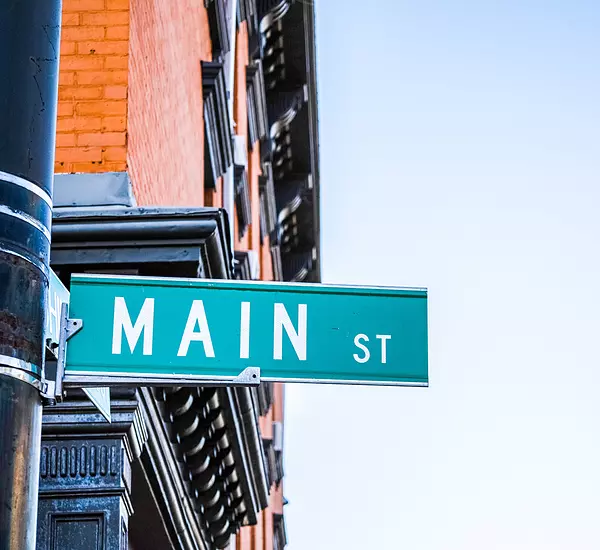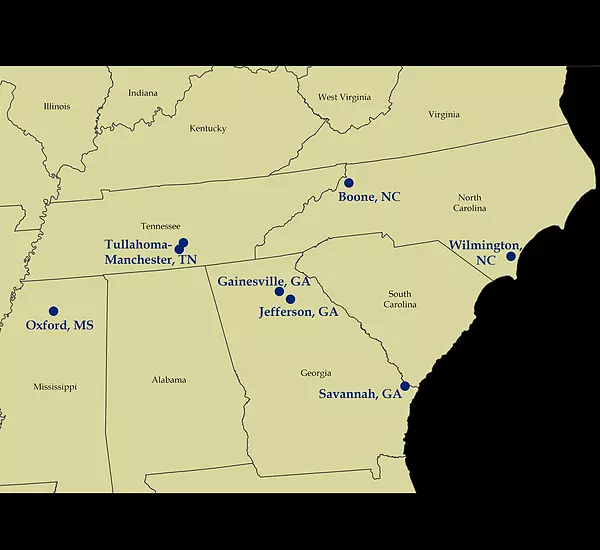
Why is small city resilience important?
Small cities are "living laboratories" for ideas on how to generate dynamic economic opportunity across a broader geography. Small cities can provide a patchwork of economic hubs with a diverse industry base, entrepreneurship, quality jobs, and quality of life for people outside major metropolitan areas where growth and opportunity are increasingly concentrated.
Why study small cities?
The success of large metropolitan areas in the south is well-documented, as places like the Research Triangle, Atlanta, Charlotte, Charleston, and Nashville are fast-growing and attractive places to live and do business.
In focusing on small cities, we see a diversity and creativity of approaches to grow local and regional economies in a resilient and dynamic way.
What is economic dynamism and resilience?
Economic resilience refers to how an economy can respond to economic shocks due to disruption of industries, economic downturns, and disasters. Resilient economies adapt to shifts and downturns and reorient the local industry base as change occurs.
Inherent in economic resilience is economic dynamism: the degree to which new businesses, ideas, and people are entering an economy and driving reinvention and innovation. In examining resilient small cities in the south, RTI considered the following factors around growth, technology, manufacturing, entrepreneurship, and education.


Where is economic resilience happening in small cities?
There is no one-size-fits-all solution to economic resilience and dynamism in small cities. They have unique and distinct profiles, and as our work shows, are found in areas of different size and geographies - we look at university-anchored, coastal, military-connected, and metro-connected cities and how they use their local assets to generate resilient growth.

How have resilient small cities changed their economic trajectory?
The RTI team explored seven locations across the Southeast to better understand how small cities are investing in themselves and using their unique assets to chart a new trajectory forward for economic dynamism “and” resilience.
What did we learn about resiliency in southern small cities?
Each city has followed a different path, demonstrating that there is no single way to build resilient economies. The following themes underscore some key tactics, investments, and approaches that resulted in positive local change over the last 20 years.

Learn more about each Southern Small City
Different types of places provide fresh ideas on ways small cities can drive toward economic resilience.
University Anchored
Open popup for University Anchored
University Anchored
The University-anchored cities of Boone and Oxford have prioritized entrepreneurship and small business development to diversify their economies to support resilient growth. These cities benefit from more than just a university presence: local university leadership is actively embracing this growth strategy alongside public investment in infrastructure and public amenities that supporting business growth and attractive quality of life.
Cross-City Insights
- University and Healthcare Anchors: Strong universities and healthcare systems provide essential assets that have protected the two cities from major economic downturns faced by many other micropolitan areas in the last two decades.
- Coordinated Entrepreneurial Support: Academic, public and private support, and investment in entrepreneurship creates a robust ecosystem for businesses to start and thrive in both cities.
- Culture of Connection: Strong social capital and local connections facilitate entry into the startup ecosystem, lower barriers to access to services, and support entrepreneurs if their ideas fail.
- Infrastructure and Amenity Investment: Basic needs including quality roads, broadband, education, and healthcare alongside outdoor amenities, arts, parks and recreation make Boone and Oxford attractive places to live and support a growing population.
- Connection to External Economic Initiatives: Boone and Oxford are both actively leveraging external statewide economic initiatives to further local efforts.
Photo Credit: Mountain BizWorks
Coastal
Open popup for Coastal
Coastal
The coastal cities of Savannah and Wilmington are examples of how small cities are pursuing economic diversification. Savannah has benefitted from historic strengths as a deep-water port and has built an active logistics, supply chain, and manufacturing industry around it. Wilmington is undergoing a rapid transformation by diversifying its industry base in manufacturing, fintech, and pharmaceuticals with a successful startup ecosystem.
Cross-City Insights
- Infrastructure and location are important assets for coastal cities, supporting trade and tourism that when leveraged appropriately can attract additional investment in supporting industries and the entrepreneurial ecosystem.
- Both cities are actively diversifying their industry base, specifically in manufacturing and logistics in Savannah and technology and finance in Wilmington.
- Savannah benefits from its continued manufacturing growth and is an attractive place for small-to-medium sized manufacturers and supply chain companies to take advantage of the port and large manufacturers.
- Entrepreneurship, including successful exits and investment networks are accelerating growth and diversification in Wilmington. This includes the success of Live Oak Bank and its spinoffs (nCino and Apiture), angel networks, and fast growing startup support hubs.
- For both cities, addressing the need for high-wage jobs, affordability, and economic mobility will be central to future growth. Historic inequities and a low-wage economy persist in light of a diversifying economy and thriving tourism sector.
Military Connected
Open popup for Military Connected
Military Connected
Tullahoma-Manchester is a region with small cities that have created resiliency and dynamism by connecting to military, educational, and industry assets to expand advanced manufacturing companies and new firms. Its economic diversification from traditional distilling to aerospace, automotive, and machinery manufacturing is the result of deliberate efforts to support technology-based development and connections to military and industrial assets in the region.
Cross-City Insights
- The city has capitalized on the research assets, talent and international reputation of Arnold Engineering Development Complex (AEDC) to promote knowledge-based jobs.
- Leaders have a proactive and long-term approach to developing economic infrastructure including industrial sites and fiber.
- The region leverages its geographic location between multiple metro regions to tap into and expand manufacturing supply chains through strong local state coordination.
- Future growth calls for ongoing coordination with the state to enhance manufacturing, and a greater collaborative relationship with AEDC and the Air Force Base to create a more active environment for innovation and entrepreneurship.
- As the city and region grows, better community amenities including downtown development, housing and greenspaces will support ongoing economic resilience.
Proximity to Major Metro
Open popup for Proximity to Major Metro
Proximity to Major Metro
Gainesville and Jefferson are taking advantage of their geographic location outside of Atlanta by leveraging the airport , interstate infrastructure, and growing population to foster business and industry growth. Pairing these attributes with savvy and coordinated state and local economic development decisions have led to automotive manufacturing supply chain development which creates spillover growth for other industries.
Cross-City Insights
- Geographic Location: The location of Gainesville and Jefferson to Atlanta and two major automotive manufacturers including Volkswagen in Chattanooga, TN and BMW in Greenville, SC has allowed these two small cities to take advantage of many nearby economic development assets.
- Physical Infrastructure: Local economic developers made strategic decisions to build out local infrastructure including highway spurs, industrial sites, and water reservoirs to meet the potential demands of companies seeking to locate or expand in the area.
- Clarity of Vision, Cooperation and Patience: Leaders have a clear focus overtime on how to ensure the region is attractive for growth based on its economic history, locational assets, and worker training.
- Foreign Direct Investment: The location of foreign-owned companies to the area is the result of decades-long relationship development by the Georgia Department of Economic Development in close coordination with local economic development officials. It resulted in one of the state's largest FDI investments in a sector primed for future growth.
Explore the data: what does your location look like?
For analysis, the data are presented at the Metropolitan Statistical Area (MSA), Micropolitan Statistical Area, and county level as defined by the White House Office of Management and Budget (OMB). For more information, see the U.S. Census Bureau.
